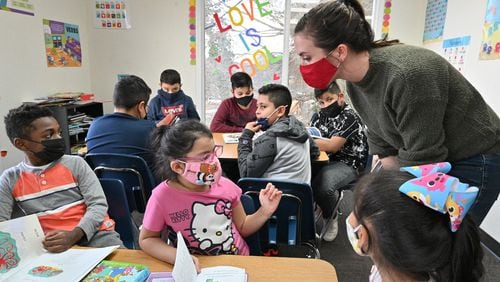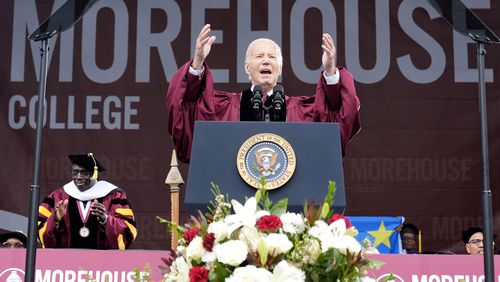In a guest column, Dana Rickman, president of the Georgia Partnership for Excellence in Education, urges the General Assembly to reconfigure education funding to reflect current student and school system needs or state priorities.
The Atlanta Journal-Constitution Get Schooled blog asked Georgia advocates for children and schools to explain what they would like to see state lawmakers tackle — or avoid — this upcoming legislative session. Rather than a laundry list, we asked for specific recommendations and advice that they believe will improve children’s lives or student outcomes. The columns will run in this space over the next two weeks.
By Dana Rickman
Between March 2020 and March 2021, Georgia was awarded $6.6 billion from the federal Elementary and Secondary School Emergency Relief Fund. The Georgia State Board of Education distributed 90% of these dollars — $5.9 billion — to local school districts and state-approved charter schools. By federal law, the ESSER program provides these grantees — jointly known as local education agencies or LEAs — significant flexibility to use ESSER funds to accelerate learning and improve student well-being based on their unique needs.
In 2021, with funding from the state Department of Education, the Georgia Partnership for Excellence in Education launched the CARES Impact Study to understand how LEAs are spending relief funds and identify best practices to help students recover from the pandemic’s negative effects on student learning and well-being. In November 2022, the partnership released the Year-One Report, which highlights challenges and opportunities associated with executing local ESSER plans. The partnership collected these insights through a combination of interviews and statewide surveys of district and state charter school leaders.
Credit: Contributed
Credit: Contributed
One of the report’s key findings is that the strategies and spending plans of LEAs have shifted since the height of the COVID-19 pandemic. From March 2020 to June 2021, LEAs responded to a first-of-its-kind crisis, transitioning to online instruction and confronting the behavioral disruptions that accompanied students’ return to the classroom. As circumstances changed during the 2021-2022 school year, however, district and school leaders turned their attention to accelerating learning and addressing barriers standing in the way of student and school success.
LEAs’ decisions about deploying federal ESSER funds have also been influenced by several components of the state’s education funding formula, which needs to be modernized. Georgia’s primary mechanism for funding public schools — the Quality Basic Education (QBE) formula — was created in 1985.
While Georgia’s General Assembly has revised the QBE twice since then, the formula does not reflect current student and school system needs or state priorities. In fact, the misalignment between structures and priorities has contributed to resource gaps for many local districts and state charter schools. The CARES Impact Study Year-One Report highlighted four areas where funding reform is a priority: technology, transportation, counseling, and dedicated funding for low-income students.
For example, the current per-student allocation for instructional materials is $55.65. These funds cover the purchase of textbooks, educational software, and other classroom technologies. To supplement those dollars, many LEAs have used ESSER funds to purchase one-to-one devices and instructional software to differentiate student learning. However, with the limited shelf life of electronic devices and the significant costs associated with executing districtwide software contracts, LEAs will struggle to sustain new infrastructure post-ESSER.
Similarly, state funds for student transportation have not kept up with district needs. The current state contribution toward student transportation costs is 15%, down from about 50% in the early 1990s. While the General Assembly appropriated $136 million for transportation costs in FY 2022, LEAs spent an additional $780 million to bus students to and from school.
Relatedly, more than three-quarters of LEAs responding to the statewide survey (77%) reported that they have used ESSER funds to hire more professionals to confront the physical and mental health challenges uncovered during the pandemic. More than a third of LEAs used ESSER funds to hire nurses (36%), followed by school counselors (33%), social workers (27%) and psychologists (14%). State funding ratios for these school roles — 450:1 for counselors and 2,475:1 for social workers and psychologists — are well above the recommended ratios for these professionals, 250:1 and 500:1, respectively.
Lastly, Georgia is one of six states that does not provide supplementary funding for low-income students. Low-income students often face barriers to learning that require additional support and resources, such as those LEAs are providing now with ESSER funds. Implementing a funding weight based on the number of low-income students in a school system could sustain these efforts.
Beyond the CARES Impact Study Year-One Report, the concerns expressed by district superintendents align with the feedback received from members of the EdQuest Coalition, a Georgia Partnership-led group of more than 40 Georgia-based organizations representing education, business, civic and nonprofit leaders invested in improving Georgia’s education and economic standing. In January 2023, the Georgia Partnership will release the revised EdQuest Georgia Framework, which was originally launched in 2017 and served as a model for education reform in Georgia.
One of the framework’s seven core areas — Adequate and Equitable Funding — focuses on state education finance. The coalition recommends that the Georgia General Assembly revise the Quality Basic Education formula to address the effects of poverty on educational outcomes and to reflect emerging district needs related to transportation, counseling, school safety, and physical and mental health supports.
The Georgia Partnership and the broader EdQuest Coalition stand prepared to support state legislators as they consider how to design a state education finance structure that coordinates investments in such a way to increase educational excellence, accelerate economic opportunity, and maintain the state’s competitive position in the global economy.
About the Author








